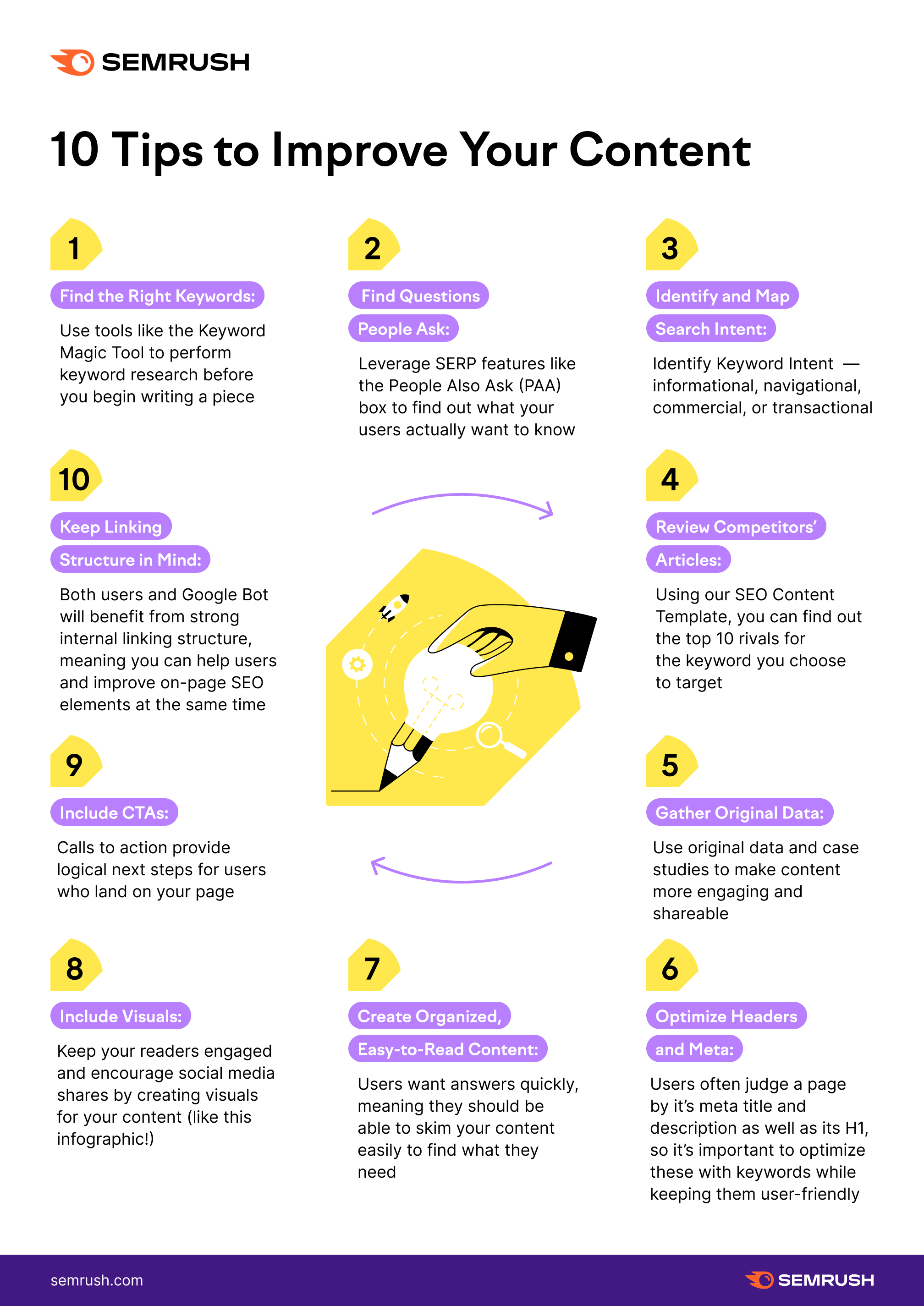Master SEO content writing with proven strategies: conduct keyword research, craft engaging headlines, optimize meta tags, use internal links, and write high-quality, reader-focused content.
In today’s digital world, knowing the best SEO practices can set you apart. Writing SEO-friendly content involves more than just using keywords. It’s about creating valuable, engaging content that meets readers’ needs. Good SEO practices improve your visibility and attract more traffic.
These practices include understanding your audience, using keywords smartly, and providing quality information. Following these guidelines helps search engines recognize your content’s value. This blog will explore the best practices for SEO content writing, helping you create content that ranks well and engages readers. Let’s dive into the essentials to boost your content’s performance.
Keyword Research
Keyword research is the backbone of SEO content writing. It helps you understand what your audience is searching for and how to meet their needs. By finding the right keywords, you can drive more traffic to your website and rank higher on search engines. Let’s dive into some best practices for keyword research.
Finding Relevant Keywords
Start by brainstorming a list of topics related to your niche. Think about what your audience wants to learn or solve. Use tools like Google Keyword Planner or Ahrefs to find popular search terms. Look at the search volume and competition for each keyword. Choose keywords that are relevant and have a good balance of search volume and competition.
Analyze your competitors to see which keywords they are targeting. Check their content and identify gaps that you can fill. This can give you an edge and help you find keywords that you might have missed.
Using Long-tail Keywords
Long-tail keywords are phrases that contain three or more words. They are more specific and less competitive than short keywords. For example, instead of “shoes,” use “comfortable running shoes for women.” Long-tail keywords attract more targeted traffic and can improve your conversion rates.
Incorporate long-tail keywords naturally into your content. Use them in headings, subheadings, and throughout your text. This makes your content more relevant to search queries and helps you rank higher. Long-tail keywords also capture the voice search audience, as people often use complete sentences when speaking to their devices.

Credit: www.anandriyer.com
Content Structure
A strong content structure enhances the readability and SEO of your posts. Proper structuring makes it easier for readers to understand the content. It also helps search engines to crawl and index your page effectively. Here are some best practices for structuring your content.
Creating Clear Headings
Clear headings are essential for both readers and search engines. They break up the content into manageable sections. This makes it easier for readers to scan and find relevant information.
Make sure your headings are descriptive and relevant to the content that follows. Avoid vague terms. Be specific and use keywords where possible.
Using Short Paragraphs
Short paragraphs improve readability. Long blocks of text can overwhelm readers. Aim for 2-4 sentences per paragraph.
Each paragraph should focus on a single idea. This keeps the content clear and concise. Use bullet points or numbered lists to highlight key points.
Here’s an example:
- Keep paragraphs short.
- Focus on one idea per paragraph.
- Use lists for key points.
Using short paragraphs helps maintain reader engagement. It also encourages readers to continue scrolling through your content.
| Element | Purpose |
|---|---|
| Headings | Break up content, improve SEO |
| Short Paragraphs | Enhance readability |
| Lists | Highlight key points |
Remember, a well-structured post is more likely to rank higher in search results. This helps attract and retain more readers.
Engaging Titles
Engaging titles are vital for drawing readers to your content. They help improve search engine rankings and entice users to click on your links. A well-crafted title can make a significant difference in your content’s performance.
Crafting Compelling Headlines
Creating compelling headlines involves understanding your audience and what they seek. Use clear and concise language. Ensure your headline reflects the content accurately.
- Use numbers for lists (e.g., “5 Tips for Better Sleep”)
- Pose questions to spark curiosity (e.g., “What Are the Benefits of Yoga?”)
- Include power words to evoke emotion (e.g., “Amazing”, “Essential”)
Remember, your headline is the first impression. Make it count.
Incorporating Keywords
Keywords play a crucial role in your SEO strategy. Including them in your titles can help search engines understand your content better. This improves your chances of ranking higher in search results.
Place the main keyword at the beginning of the title. This helps search engines and readers identify the topic quickly.
| Do | Don’t |
|---|---|
| Include primary keywords | Overstuff with keywords |
| Keep it natural | Force keywords unnaturally |
Use long-tail keywords to target more specific queries. This can help attract a more targeted audience.
By combining compelling headlines with strategic keyword placement, you can create engaging titles that boost your SEO and attract readers.

Credit: sunnysidesocialmedia.com
Optimizing Meta Descriptions
Optimizing meta descriptions is crucial for improving your website’s visibility. Meta descriptions give search engines a summary of your page content. They also influence users to click on your link. Let’s explore how to write effective meta descriptions.
Writing Descriptive Snippets
A meta description should be brief and to the point. Aim for 150-160 characters. This keeps your snippet from being cut off in search results. Use clear and engaging language to attract readers.
Here’s a simple example of a good meta description:
| Bad Meta Description | Good Meta Description |
|---|---|
| Welcome to our site. We offer many products. | Discover a variety of products at great prices. Shop now! |
Including Target Keywords
Incorporating target keywords in your meta descriptions boosts SEO. Search engines highlight these keywords in search results. This draws attention to your link.
Here are some tips for including keywords:
- Use one or two primary keywords.
- Place keywords near the beginning.
- Avoid keyword stuffing.
Example:
Meta Description: “Find the best coffee maker for your home. Compare top models and reviews.”
Internal And External Links
Internal and external links play a vital role in SEO content writing. They help search engines understand your content better. They also guide readers through your website. Proper use of these links can improve your website’s ranking and user experience. Let’s explore the best practices for using internal and external links in your content.
Building Internal Links
Internal links connect different pages on your website. They help keep users engaged by guiding them to relevant content. Use descriptive anchor text for your internal links. This helps search engines understand the linked page’s content.
Place internal links naturally within your content. Avoid forcing links where they don’t fit. Link to older blog posts or important pages. This helps distribute page authority across your site.
Regularly update your internal links. Ensure they point to active and relevant pages. Broken links can harm user experience and SEO.
Adding Credible External Links
External links point to pages on other websites. They add value by providing additional information. Link to reputable sources. This boosts your content’s credibility.
Avoid linking to low-quality or spammy sites. They can harm your website’s reputation. Use external links to back up your claims or provide further reading.
Ensure external links open in a new tab. This keeps users on your site longer. Use sparingly to avoid overwhelming your readers.
Multimedia Integration
Multimedia integration is key to engaging your audience. Adding images, videos, and other media can make your content more interesting. It can also help with SEO. Search engines like to see varied content types. Let’s explore some best practices for using multimedia in your SEO content.
Using Images And Videos
Images and videos break up text and make it easier to read. They can also illustrate points better than words alone. Use high-quality, relevant images to support your content. Videos can explain complex ideas and keep visitors on your page longer. This can reduce your bounce rate and improve your rankings.
Optimizing Alt Text
Alt text is a description of an image for search engines. It helps them understand the content of the image. Use clear and concise alt text for each image. Describe what the image shows in simple words. This can help your images appear in search results. It also improves accessibility for visually impaired users.
Mobile-friendly Content
Mobile-friendly content is crucial for SEO success. People use their phones for browsing more than ever. Ensuring your content looks good on mobile is key. Read on to learn best practices.
Ensuring Responsive Design
A responsive design adjusts your site to fit any screen size. This makes your content easy to read on phones and tablets. Use a mobile-first approach when designing your site. Test your site on different devices. Ensure images and text scale properly.
Improving Load Times
Load times affect user experience and SEO rankings. Slow pages frustrate users and drive them away. Compress images to reduce file sizes. Use a reliable hosting service for better performance. Limit the use of heavy scripts and plugins. Keep your website lean and fast.
Content Updates
Content updates play a crucial role in maintaining the relevance and authority of your website. Regularly updating your content ensures it stays fresh, accurate, and engaging. This practice not only enhances user experience but also keeps search engines interested in your site. Below, we will explore two key aspects of content updates: Refreshing Old Content and Monitoring SEO Performance.
Refreshing Old Content
Refreshing old content is an effective way to keep your website current. Start by identifying high-performing posts. Update the information to reflect the latest trends and data. Add new insights or examples to make the content more valuable. This can help boost your search rankings.
Consider updating headlines to make them more compelling. Optimize images and add new multimedia elements. Ensure all links are functional and relevant. This practice can breathe new life into your content and attract more traffic.
Monitoring Seo Performance
Monitoring SEO performance is essential for understanding the impact of your content updates. Tools like Google Analytics can be used to track changes in traffic and user behavior. Pay attention to metrics like page views, bounce rate, and average session duration.
Regularly check keyword rankings. See how your updated content is performing compared to previous versions. This helps identify what works and what needs improvement. Adjust your strategies based on the insights you gather.
Engage with your audience through comments and feedback. This provides valuable information on their needs and preferences. Use this feedback to refine and optimize your content further.

Credit: contentwriters.com
Frequently Asked Questions
What Is Seo Content Writing?
SEO content writing involves creating content optimized for search engines. It includes keyword research, on-page optimization, and user engagement.
How To Do Keyword Research?
Use tools like Google Keyword Planner. Identify relevant keywords with high search volume and low competition.
Why Is On-page Optimization Important?
On-page optimization helps search engines understand your content. It improves your chances of ranking higher in search results.
How To Improve Content Readability?
Use short sentences and paragraphs. Incorporate subheadings, bullet points, and images to make the content more engaging.
Conclusion
Effective SEO content writing requires focus and dedication. Prioritize quality and relevance. Always use keywords naturally within your content. Keep sentences short and clear for better readability. Consistent updates and improvements help maintain search engine rankings. Engaging your audience with valuable information is key.
Regularly monitor performance to refine your strategy. By following these practices, your content will attract more visitors. Stay committed to learning and adapting. Success in SEO content writing is a continuous journey. Keep improving your skills and you will see results.

